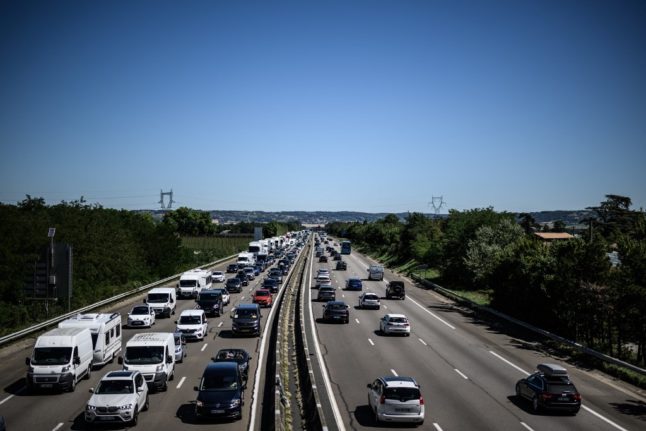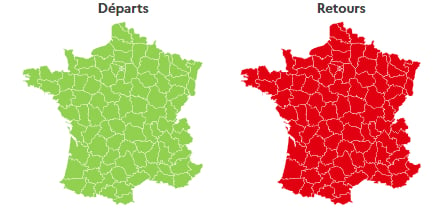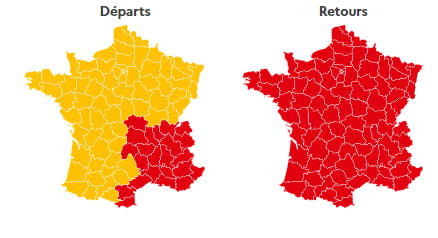The country’s roads watchdog Bison Futé predicts very difficult travel conditions on major routes across the whole of the country, as holidaymakers head home on the penultimate weekend of les grandes vacances.
On Friday, the traffic monitor advises forecasts no particular problems for anyone travelling to holiday destinations, but advises road users heading home from popular resorts to:
- Avoid the A13 between Rouen and Paris, from 5pm to 7pm;
- Avoid the A10 between Bordeaux and Poitiers, from 12pm to 2pm;
- Avoid the A8 between Nice and Aix-en-Provence, from 2pm to 6pm;
- Avoid the A71 between Clermont-Ferrand and Orléans, from 11am to 3pm;
- Avoid the A61 between Narbonne and Toulouse, from 4pm to 7pm;
- Avoid the Mont-Blanc tunnel in direction of France, from 1pm to 9pm.
Saturday travel, however, looks set to be more complicated, with Bison Fute predicting ‘difficult’ or ‘very difficult’ conditions in both directions.
For outward journeys, it recommends that motorists should:
- leave or cross the Île-de-France before 10am;
- avoid the A13, between Paris and Rouen from 11am to 2pm;
- avoid the A11, between Paris and Le Mans from 12pm to 6pm;
- avoid the A10 freeway, between Orleans and Tours from 10am to 5pm, and between Bordeaux and Poitiers from 11am to 4pm;
- avoid the A6 between Beaune and Lyon from 10am to 5pm;
- avoid the A7 between Lyon and Orange from 8am to 6pm;
- avoid the A20 between Limoges and Brive-la-Gaillarde from 11am to 5pm;
- avoid the A71 between Orléans and Clermont-Ferrand from 10am to 4pm;
- avoid the A62 between Bordeaux and Toulouse from 11am to 5pm;
- avoid the A61 between Toulouse and Narbonne from 10am to 3pm.
For return journeys on Saturday, road users are advised to:
- return to or cross the Île-de-France before 2pm;
- avoid the A11 between Le Mans and Paris from 11am to 2pm;
- avoid the A10 between Bordeaux and Poitiers from 10am to 3pm;
- avoid the A6 between Lyon and Beaune from 1pm to 5pm;
- avoid the A7 between Orange and Salon-de-Provence from 9am to 2pm;
- avoid the A8 between Nice and Aix-en-Provence from 10am to 1pm;
- avoid the A9 between Spain and Orange from 10am to 2pm;
- avoid the A71 between Clermont-Ferrand and Bourges from 3pm to 6pm, and between Bourges and Orléans from 9am to 12pm;
- avoid the A61 between Narbonne and Toulouse from 10am to 3pm;
- avoid the A75 between Montpellier and Clermont-Ferrand from 12h to 14h;
- avoid the Mont-Blanc tunnel in direction of France, from 4pm to 9pm.
Traffic levels ease a little on Sunday for those heading towards popular French tourist resorts, but are still considered ‘very difficult’ for those heading back home
The following advice is in place for outward journeys in France on Sunday
- avoid the A7 between Lyon and Orange from 3pm to 9pm;
- avoid the A9 between Montpellier and Narbonne from 3pm to 5pm;
- avoid the A62 between Bordeaux and Toulouse from 4pm to 9pm;
- avoid the A61 between Toulouse and Narbonne from 3pm to 5pm.
For return journeys, the advice is:
- return to or cross the Ile-de-France before 12pm,
- avoid the A11 between Le Mans and Paris from 3pm to 9pm,
- avoid the A10 at the Saint-Arnoult-en-Yvelines tollgate from 4pm to 8pm, and between Bordeaux and Poitiers, from 11am to 5pm,
- avoid the A6 between Lyon and Beaune from 11am to 9pm,
- avoid the A7 between Lyon and Salon-de-Provence from 10am to 6pm,
- avoid the A8 between Nice and Aix-en-Provence from 10am to 9pm,
- avoid the A71 between Clermont-Ferrand and Bourges from 10am to 12pm,
- avoid the Mont-Blanc tunnel in the direction of France from 2pm to 7pm.






 Please whitelist us to continue reading.
Please whitelist us to continue reading.
Member comments